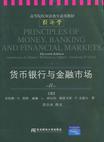货币银行与金融市场
出版时间:2008-10 出版社:东北财大 作者:(美)劳伦斯·S.里特//威廉·L.西尔伯//格雷戈里·F.尤德尔|译者:范立夫 页数:398 译者:范立夫
Tag标签:无
前言
2l世纪是开放经济的时代。我们正处在一个不断开放的国度、一个开放经济不断深化的时代。伴随着我国加入WT0时间的推移,我国经济的开放程度不断深化,在经济全球化的时代背景下,我国融入国际社会的进程正在而且必将进一步加快。 21世纪是知识经济的时代。知识成为决定经济增长的最主要的生产要素之一,人力资本在经济增长中的作用日益凸显。 21世纪,各国经济实力和综合国力的竞争将日趋激烈。未来的竞争将是人才的竞争,培养富有创新精神和能力的开放型人才已成为2l世纪实现中华民族的伟大复兴的关键,这也正是我国20世纪90年代提出并实施科教兴国战略的意义所在。 基于对上述趋势的考量,对开放型人才培养模式的探索将成为我国高等教育改革的关键一环。毋庸置疑,出国留学是培养开放型人才的有效途径,这一点能从我国近几年出国留学人数的激增上得到明显的例证,但这一方式毫无疑问并不适用于大多数人,推动我国高等教育的国际化、提高我国高等教育的国际化水平才是培养开放型人才的最有效途径,而且是21世纪世界高等教育发展的大势所趋,也是我国高等教育与国际接轨的应有之义和提高我国高等教育水平的必然的路径选择之一。 在教育部的大力推动下,作为高等教育国际化的实现机制之一,双语教学已被纳入《普通高等学校本科教学工作水平评估方案》(试行),并在全国高等学校得到大力开展和推广。教材建设无疑是双语教学的重要载体,而且成为决定双语教学成功与否的关键问题之一。
内容概要
本书对金融机构,货币理论政策做了简明的、现代化的和完整的描述。从现代分析视角出发,并以轻松的谈话式的风格来阐述问题。除此之外,这一版更突出了以下特色: 1.通俗易懂。根据读者的学习能力,遵循“必需、够用”的原则,对理论部分做了大量的精简,力图使理论讲述言简意赅、脉络清晰。删减了学生感到困难的理论推导,保留了基本理论的内容,从而做到既简单懂又不失理论核心的完整性。 2.形式新颖。为了满足金融专来的学生学习。适应的财经类专业教学的需要,在体例、结构、版式方面,做了一些尝试性创新。例如,在每一章的开头介绍了本章所要讲授的主要内容,使学生对本章内容有个大致的了解,而且各章都穿插了可读性强、有趣味且能够帮助学生加深理解的相关资料等。
作者简介
劳伦斯·S.里特纽约大学斯特恩商学院的金融学和经济学名誉退休教授。他曾经担任过纽约联邦储备银行国内经济研究部主任,而且还是美国财政部、联邦存款保险公司、美联储、美国银行家协会、联储银行银行家协会和加尔文盖巴特勒公司的顾问。
书籍目录
第1部分 导论 第1章 货币银行与金融市场导论 概览 为什么学习货币、银行与金融市场学 银行和金融市场的职位 第2章 货币在宏观经济中的作用 货币简介 货币、经济与通货膨胀 第3章 金融工具、市场与机构 资金的流动 金融工具与市场 金融中介机构:作用和构成第2部分 金融工具与市场 第4章 利率的计量及影响 计算利率 什么决定利率水平? 第5章 利率的风险结构和期限结构 利率期限结构和收益率曲线 利率风险和税收结构 附录:债券价格变动的衡量:久期与到期日 第6章 证券市场的结构和运行 证券市场的特征和功能 二级市场的交易效率 资本市场的有效性及监管 第7章 货币市场和资本市场 政府债券市场 与商业银行相关的证券:大额可转让定期存单和欧洲美元 公司证券 市政债券 抵押债券 股票市场 第8章 解密衍生产品 金融期货概览 期权合约概览 互换概览 第9章 理解外汇 什么决定外汇汇率? 固定与浮动汇率第3部分 银行和其他中介 第10章 金融中介的本质 金融中介的经济学分析 美国金融中介机构的演变 金融中介:资产、负债和管理 第11章 存款类金融机构 银行管理基础 银行管理的主要趋势 非银行存款机构——储蓄节俭机构 第12章 非存款金融机构 人寿保险公司 财产和灾害保险公司 共同基金 金融公司 证券经纪人、经销商和投资银行 风险投资基金、夹层债务基金和对冲基金 商业银行和非存款金融机构第4部分 中央银行的艺术 第13章 由谁负责? 联邦储备体系的正式结构 ……第5部分 货币理论
章节摘录
Lets take our favorite option, the IBM calls with a strike price of $80. Theprice of such equity options is usually quoted per share, which means thatmultiplying by 100 (the number of shares the call owner is entitled to buy)gives the dollar price of the option. For example, the June IBM 80 call optionis quoted at $3, and so it costs $300 to buy; if the option were quoted at $15, itwould cost $1,500, and so on. What determines whether the price of the IBM80 calls is $3, $15, or $35? The three main factors are the current price of IBMstock, the volatility of IBMs stock price, and the time to expiration of theoption. We will look at each factor in turn. It should be fairly intuitive that a call option with a given exercise pricewill be worth more the higher the price of the underlying asset. If IBM stock isselling for $90, the $80 call gives you the fight to buy 100 shares at a pricewhich is $10 below the price at which you could sell the shares. Thus everyonewould pay at least $10 for the IBM $80 calls if IBM stock sells for $90, sincethey could lock in an immediate profit if the call were selling for less. If IBMstock were selling for $110, for example, the $80 call would be worth at least$30. Somewhat more generally, options will sell for at least their intrinsicvalue at any time, even prior to expiration. And that means that a higher stockprice implies a higher call value at all times. But that can hardly be the entire story. If IBM stock were selling at $80 pershare, the intrinsic value of the $80 calls would be zero, but the options couldstill be quite valuable. And that is especially true if the calls have a significantamount of time left before expiration. In particular, if the price of IBM is veryvolatile, and there is a lot of time before the option expires, then there isalways a chance that the price could move up significantly between now andexpiration. The greater the volatility of IBM stock, the higher its price can go,hence the more the call could be worth on expiration. Therefore, given thecurrent price of the stock, call buyers will pay more for a call option if theunderlying stock is more volatile than otherwise. A similar argument makesoption sellers less willing to write options on stock with large price volatility.Thus for any given price of the underlying asset, call option premiums will belarger for stocks with high price volatility.
图书封面
图书标签Tags
无
评论、评分、阅读与下载
用户评论 (总计0条)
相关图书
- 中文版InDesign CS3完全学习手册
- MSC.ADAMS技术与工程分析实例
- Java应用开发技术基础
- 基础会计实训
- 人体工程学与室内设计
- 全国高校“十一五”旅游专业新创规划教材
- 新阶进实用英语(第3册)
- 跨国管理
- MasterCAM X2模具加工实例图解
- 新阶进实用英语(第4册)
- ERP系统原理和实施
- 电子商务综合实验
- 劳动合同法实施条例
- 劳动合同法及其实施条例实用问答
- 税法学学习指导
- 企业纳税明明白白
- 银行公司治理研究
- 资产证券化投资利益保护机制研究
- 反垄断法专题研究
- 海洋资源保护法律制度研究
- 契约多重性下银行与客户利益格局的法律研究
- 商品住房买卖贷款按揭法律问题研究
- 金融领域法律规制新视域
- 经济法的基本范畴研究
- 福利供给变迁中的经济法功能研究
